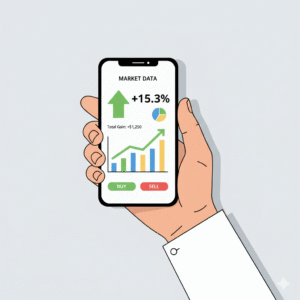How does the stock market work?

The stock market. The words conjure images of frantic traders on the floor of the New York Stock Exchange, scrolling green and red numbers on a screen, and legendary investors like Warren Buffett. It can seem like a complex, intimidating world reserved only for financial experts.
But at its core, the stock market is built on a simple, powerful idea: connecting companies that need money to grow with people who have money to invest. It’s a system that has fueled innovation, built global empires, and helped millions of ordinary people build wealth for their retirement, their children’s education, and their long-term goals.
If you’ve ever wondered what it really means when you hear that “the market is up,” or how buying a single share of Apple makes you a part-owner, you’ve come to the right place. This guide will demystify the stock market from the ground up. We’ll break down what a stock is, how prices are set, and how you can take your first steps toward becoming an investor.
Why Does the Stock Market Exist in the First Place?

To understand how the market works, you first need to understand why it exists. Imagine a successful local coffee shop. The owner wants to expand by opening ten new locations, but she needs $1 million to do it—money she doesn’t have.
She has a few options, but one of the most powerful is to “go public.” This means she decides to sell off small pieces of ownership in her company to raise the money. These pieces of ownership are called stocks or shares.
By selling shares to the public, the company gets the cash it needs to grow (the $1 million for new stores). In return, the people who buy the shares—the investors—become part-owners of the coffee shop business. If the new stores are successful and the company’s profits grow, the value of their ownership stake (their shares) increases. They can then sell those shares to other investors for a profit.
The stock market is simply the organized, regulated network where this buying and selling of ownership pieces takes place. It’s the ultimate marketplace for corporate ownership.
What is a Stock? Unpacking Your Slice of the Corporate Pie
A stock is more than just a number on a screen or a ticker symbol like AAPL (Apple) or F (Ford). A share of stock represents a claim on a company’s assets and earnings.
Think of a company as a whole pizza. When you buy one share of stock, you are buying one slice of that pizza.
- If the company has 1,000 shares outstanding and you own 10, you own 1% of the company.
- As an owner, you are entitled to your portion of the company’s profits, which are sometimes paid out to shareholders as dividends.
- You also get voting rights. Shareholders can vote on major corporate decisions, such as electing the board of directors.
When you hear that a stock’s “price” is $150, that is the cost to buy one slice of that company’s pizza at that exact moment. Your goal as an investor is to buy slices of companies that you believe will become more successful and profitable over time, making your slice more valuable.
The Two Arenas: Understanding the Primary and Secondary Markets

The stock market is actually composed of two distinct parts:
The Primary Market: The Grand Opening
This is where stocks are born. When our coffee shop owner decides to sell shares to the public for the very first time, this event is called an Initial Public Offering (IPO). The company, with the help of investment banks, sets an initial price for its shares and sells them directly to investors. The money from this sale goes straight to the company to fund its growth.
The Secondary Market: The Everyday Trading Floor
This is what most people think of as “the stock market.” It’s where investors buy and sell shares from each other. When you go to your brokerage account and buy 10 shares of Microsoft, you aren’t buying them from Microsoft. You’re buying them from another investor who decided to sell them. The price is determined by the agreement between you (the buyer) and the seller.
The vast majority of daily trading happens on the secondary market. Major stock exchanges like the New York Stock Exchange (NYSE) and the NASDAQ are the most famous secondary markets. They act as regulated auction houses, ensuring that trading is fair, orderly, and transparent.
The Heart of the Market: How Supply and Demand Drive Stock Prices
So, what makes a stock’s price go from $150 to $155, or fall to $145? The answer is the single most important concept in all of economics: supply and demand.
- Supply refers to the number of shares available for sale at any given time.
- Demand refers to the number of shares that investors want to buy.
When demand is higher than supply (more buyers than sellers), the price of the stock is bid up.
When supply is higher than demand (more sellers than buyers), the price of the stock is pushed down.
This constant tug-of-war happens millions of times per second for thousands of different stocks. But what influences a person’s decision to buy or sell?
- Company Performance: This is the biggest driver. If a company reports higher-than-expected profits, launches a revolutionary new product, or announces a major partnership, more investors will want to own it. Demand rises, and the stock price goes up. Conversely, a bad earnings report or a product recall will cause investors to sell, increasing supply and pushing the price down.
- Economic News: Broad economic data affects all companies. Low unemployment, strong GDP growth, and low interest rates are generally good for business, creating optimism and pushing stock prices up. High inflation or signs of a recession can create fear, leading to widespread selling.
- Investor Sentiment and Psychology: Markets aren’t always rational. They are driven by human emotions. A wave of optimism (a “bull market”) can cause prices to rise beyond their fundamental value. A wave of fear (a “bear market”) can cause prices to crash, even for healthy companies.
- World Events: Geopolitical conflicts, natural disasters, technological breakthroughs, and changes in government regulations can all have a significant and immediate impact on supply and demand for certain stocks or the market as a whole.
How Do We Measure the Market? A Look at Major Stock Indexes

It would be impossible to track the performance of all 6,000+ stocks trading in the U.S. Instead, we use stock market indexes to get a quick snapshot of the market’s overall health and direction. An index is a curated portfolio of stocks that represents a portion of the market.
Think of it as a report card. The three most-watched indexes in the U.S. are:
- The S&P 500: The Standard & Poor’s 500 is often considered the best representation of the overall U.S. stock market. It tracks the performance of 500 of the largest and most influential publicly traded companies in America, across all major industries.
- The Dow Jones Industrial Average (DJIA): Often just called “the Dow,” this is the oldest and most famous index. It tracks 30 large, well-established “blue-chip” companies like Coca-Cola, Boeing, and Goldman Sachs. Because it’s so small, it’s more of a symbolic measure than a comprehensive one.
- The NASDAQ Composite: This index tracks nearly all of the stocks listed on the NASDAQ stock exchange. It is heavily weighted toward the technology sector, including giants like Apple, Amazon, Microsoft, and Google. It’s often seen as a barometer for the tech industry’s health.
When a news anchor says, “The market was up 200 points today,” they are usually referring to the change in one of these indexes.
Your Step-by-Step Guide to Getting Started in the Stock Market
The good news is that you no longer need to be a millionaire or call a stockbroker on the phone to invest. Technology has made it accessible to everyone. Here’s a simplified roadmap:
- Open a Brokerage Account: A brokerage account is a special type of account designed to hold investments. Think of it as a bank account for your stocks. There are many reputable online brokers like Fidelity, Charles Schwab, Vanguard, and E*TRADE, many of which offer zero-commission trading.
- Fund Your Account: You can connect your regular bank account and transfer money into your brokerage account. It’s wise to start with an amount you are comfortable losing, as all investing involves risk. You don’t need thousands of dollars; you can start with as little as $100.
- Research Your Investments: This is the most important step. Don’t just buy a stock because you saw it on the news or a friend recommended it. Research the company. Do you understand its business? Do you believe in its long-term future? A great starting point for beginners is to invest in a low-cost S&P 500 index fund or ETF, which gives you instant diversification across 500 companies.
- Place Your Order: Once you’ve decided what to buy, you’ll need to place an order through your broker’s website or app. You’ll specify the stock’s ticker symbol (e.g., AAPL) and how many shares you want to buy. You’ll typically have two main order types:
- Market Order: Buys the stock immediately at the best available current price.
- Limit Order: Lets you set a specific price you’re willing to pay. The order will only execute if the stock’s price hits your target.
- Hold and Monitor: Investing is not about frantic, daily trading. It’s about buying and holding quality assets for the long term, allowing them to grow over years, not days.
Understanding Market Psychology: What Are Bull and Bear Markets?

You’ll often hear Wall Street described with animal metaphors, primarily bulls and bears. These terms describe the overall sentiment and direction of the market.
- Bull Market: A bull market is a period of sustained optimism, investor confidence, and rising stock prices. The economy is typically strong, and unemployment is low. The term comes from the way a bull thrusts its horns up into the air.
- Bear Market: A bear market is the opposite. It’s a period of pessimism and falling prices, typically defined as a decline of 20% or more from recent highs. Bear markets are often associated with economic recessions. The term comes from the way a bear swipes its paws downward.
Understanding these cycles is key. It’s easy to be a confident investor in a bull market. The real test is having the discipline to stick to your long-term plan during the inevitable fear and uncertainty of a bear market.
The Big Question: Is Investing in the Stock Market Right for You?
The stock market has historically been one of the most effective tools for wealth creation over the long run, consistently outperforming savings accounts, gold, and real estate. However, those higher returns come with higher risk. The value of your investments can and will go down.
Investing in the stock market is generally right for individuals who:
- Have a long-term time horizon (5+ years).
- Are willing to accept the risk of short-term price fluctuations.
- Have taken care of financial basics first, like paying off high-interest debt and building an emergency fund.
By starting with a solid foundation of knowledge, a clear plan, and a long-term perspective, you can harness the power of the stock market to work toward your most important financial goals. It’s not just a game for Wall Street—it’s a tool for you.







